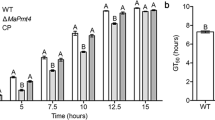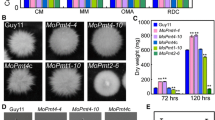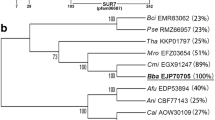Abstract
Protein O-mannosyltransferases (Pmts) belong to a highly conserved protein family responsible for the initiation of O-glycosylation of many proteins. Pmts contain one dolichyl-phosphate-mannose-protein mannosyltransferases (PMT) domain and three MIR motifs (mannosyltransferase, inositol triphosphate, and ryanodine receptor) that are essential for activity in yeast. We report that in the insect fungal pathogen, Beauveria bassiana, deletion of the C-terminal Pmt1 MIR-containing region (Pmt1∆ 311–902) does not alter O-mannosyltransferase activity, but does increase total cell wall protein O-mannosylation levels and results in phenotypic changes in fungal development and cell wall stability. B. bassiana mutants harboring the Pmt1 ∆ 311–902 mutation displayed a significant increase in conidiation with up-regulation of conidiation-associated genes and an increase in biomass accumulation as compared to the wild-type parent. However, decreased vegetative growth and blastospore production was noted, and Pmt1 ∆ 311–902 mutants were altered in cell wall composition and cell surface features. Insect bioassays revealed little effect on virulence for the Pmt1 ∆ 311–902 strain via cuticle infection or intrahemocoel injection assays, although differences in hyphal body differentiation in the host hemolymph and up-regulation of virulence-associated genes were noted. These data suggest novel roles for Pmt1 in negatively regulating conidiation and demonstrate that the C-terminal Pmt1 MIR-containing region is dispensable for enzymatic activity and organismal virulence.






Similar content being viewed by others
References
Audic S, Claverie JM (1997) The significance of digital gene expression profiles. Genome Res 7:986–995
Bidochka MJ, Clark DC, Lewis MW, Keyhani NO (2010) Could insect phagocytic avoidance by entomogenous fungi have evolved via selection against soil amoeboid predators? Microbiol 156:2164–2171
Buck JW, Andrews JH (1999) Attachment of the yeast Rhodosporidium toruloides is mediated by adhesives localized at sites of bud cell development. Appl Environ Microbiol 65:465–471
Chen Y, Zhu J, Ying SH, Feng MG (2014) Three mitogen-activated protein kinases required for cell wall integrity contribute greatly to biocontrol potential of a fungal entomopathogen. PLoS One 9:e87948
Cho EM, Liu L, Farmerie W, Keyhani NO (2006) EST analysis of cDNA libraries from the entomopathogenic fungus Beauveria (Cordyceps) bassiana. I. Evidence for stage-specific gene expression in aerial conidia, in vitro blastospores and submerged conidia. Microbiol 152:2843–2854
De Groot PW, Ram AF, Klis FM (2005) Features and functions of covalently linked proteins in fungal cell walls. Fungal Genet Biol 42:657–675
Dubois M, Gilles KA, Hamilton JK, Rebers PA, Smith F (1956) Colorimetric method for determination of sugars and related substances. Anal Chem 28:350–356
Fang W, Zhang Y, Yang X, Zheng X, Duan H, Li Y, Pei Y (2004) Agrobacterium tumefaciens-mediated transformation of Beauveria bassiana using an herbicide resistance gene as a selection marker. J Invertebr Pathol 85:18–24
Fang W, Ding W, Wang B, Zhou H, Ouyang H, Ming J, Jin C (2010) Reduced expression of the O-mannosyltransferase 2 (AfPmt2) leads to deficient cell wall and abnormal polarity in Aspergillus fumigatus. Glycobiology 20:542–552
Fernández-Álvarez A, Elías-Villalobos A, Ibeas JI (2009) The O-mannosyltransferase PMT4 is essential for normal appressorium formation and penetration in Ustilago maydis. Plant Cell 21:3397–3412
Fernández-Álvarez A, Marín-Menguiano M, Lanver D, Jiménez-Martín A, Elías-Villalobos A, Pérez-Pulido AJ, Kahmann R, Ibeas JI (2012) Identification of O-mannosylated virulence factors in Ustilago maydis. PLoS Pathog 8:e1002563
Frieman MB, Cormack BP (2003) The ω-site sequence of glycosylphosphatidylinositol-anchored proteins in Saccharomyces cerevisiae can determine distribution between the membrane and the cell wall. Mol Microbiol 50:883–896
Frieman MB, McCaffery JM, Cormack BP (2002) Modular domain structure in the Candida glabrata adhesin Epa1p, a β 1, 6 glucan-cross-linked cell wall protein. Mol Microbiol 46:479–492
Gaur NK, Klotz SA (1997) Expression, cloning, and characterization of a Candida albicans gene, ALA1, that confers adherence properties upon Saccharomyces cerevisiae for extracellular matrix proteins. Infect Immun 65:5289–5294
Gentzsch M, Tanner W (1996) The PMT gene family: protein O-glycosylation in Saccharomyces cerevisiae is vital. EMBO J 15:5752–5759
Gentzsch M, Tanner W (1997) Protein-O-glycosylation in yeast: protein-specific mannosyltransferases. Glycobiology 4:481–486
Gentzsch M, Immervoll T, Tanner W (1995) Protein O-glycosylation in Saccharomyces cerevisiae: the protein O-mannosyltransferases Pmt1p and Pmt2p function as heterodimer. FEBS Lett 377:128–130
Girrbach V, Strahl S (2003) Members of the evolutionary conserved PMT family of protein O-mannosyltransferases form distinct protein complexes among themselves. J Biol Chem 278:12554–12562
Girrbach V, Zeller T, Priesmeier M, Strahl-Bolsinger S (2000) Structure-function analysis of the dolichyl phosphate-mannose: protein O-mannosyltransferase ScPmt1p. J Biol Chem 275:19288–19296
González M, Brito N, Frías M, González C (2013) Botrytis cinerea protein O-mannosyltransferases play crucial roles in morphogenesis, growth, and virulence. PLoS One 8:e65924
Górka-Nieć W, Pniewski M, Kania A, Perlińska-Lenart U, Palamarczyk G, Kruszewska JS (2008) Disruption of Trichoderma reesei gene encoding protein O-mannosyltransferase I results in a decrease of the enzyme activity and alteration of cell wall composition. Acta Biochim Pol 55:251–259
Harries E, Gandía M, Carmona L, Marcos JF (2015) The Penicillium digitatum protein O-mannosyltransferase Pmt2 is required for cell wall integrity, conidiogenesis, virulence and sensitivity to the antifungal peptide PAF26. Mol Plant Pathol 16:748–761
He P, Lee SJ, Lin S, Seidler U, Lang F, Fejes-Toth G, Naray-Fejes-Toth A, Yun CC (2011) Serum- and glucocorticoid-induced kinase 3 in recycling endosomes mediates acute activation of Na+/H+ exchanger NHE3 by glucocorticoids. Mol Biol Cell 22:3812–3825
He Z, Zhang S, Keyhani NO, Song Y, Huang S, Pei Y, Zhang Y (2015) A novel mitochondrial membrane protein, Ohmm, limits fungal oxidative stress resistance and virulence in the insect fungal pathogen Beauveria bassiana. Environ Microbiol 17:4213–4238
Holder DJ, Keyhani NO (2005) Adhesion of the entomopathogenic fungus Beauveria (Cordyceps) bassiana to substrata. Appl Environ Microbiol 71:5260–5266
Holder DJ, Kirkland BH, Lewis MW, Keyhani NO (2007) Surface characteristics of the entomopathogenic fungus Beauveria (Cordyceps) bassiana. Microbiol 153:3448–3457
Jin K, Zhang Y, Luo Z, Xiao Y, Fan Y, Wu D, Pei Y (2008) An improved method for Beauveria bassiana transformation using phosphinothricin acetlytransferase and green fluorescent protein fusion gene as a selectable and visible marker. Biotechnol Lett 30:1379–1383
Kapteyn JC, Van Egmond P, Sievi E, Van Den Ende H, Makarow M, Klis FM (1999) The contribution of the O-glycosylated protein Pir2p/Hsp150 to the construction of the yeast cell wall in wild-type cells and β-1,6-glucan-deficient mutants. Mol Microbiol 31:1835–1844
Kim S, Ahn IP, Rho HS, Lee YH (2005) MHP1, a Magnaporthe grisea hydrophobin gene, is required for fungal development and plant colonization. Mol Microbiol 57:1224–1237
Kim H, Moon HY, Lee D-j, Cheon SA, Yoo SJ, Park J-N, Agaphonov MO, Oh D-B, Kwon O, Kang HA (2013) Functional and molecular characterization of novel Hansenula polymorpha genes, HpPMT5 and HpPMT6, encoding protein O-mannosyltransferases. Fungal Genet Biol 58-59:10–24
Klis FM, Ram AFJ, Montijn RC, Kapteyn JC, Caro LHP, Vossen JH, Van Berkel MAA, Brekelmans SSC, Van den Ende H (1998) Posttranslational modifications of secretory proteins. Methods Microbiol 26:223–238
Kriangkripipat T, Momany M (2009) Aspergillus nidulans protein O-mannosyltransferases play roles in cell wall integrity and developmental patterning. Eukaryot Cell 8:1475–1485
Lengeler KB, Tielker D, Ernst JF (2008) Protein-O-mannosyltransferases in virulence and development. Cell Mol Life Sci 65:528–544
Lewis MW, Robalino IV, Keyhani NO (2009) Uptake of the fluorescent probe FM4-64 by hyphae and haemolymph-derived in vivo hyphal bodies of the entomopathogenic fungus Beauveria bassiana. Microbiol 155:3110–3120
Liu Q, Ying SH, Li JG, Tian CG, Feng MG (2013) Insight into the transcriptional regulation of Msn2 required for conidiation, multi-stress responses and virulence of two entomopathogenic fungi. Fungal Genet Biol 54:42–51
Loibl M, Strahl S (2013) Protein O-mannosylation: what we have learned from baker’s yeast. Biochim Biophys Acta 1833:2438–2446
Lommel M, Strahl S (2009) Protein O-mannosylation: conserved from bacteria to humans. Glycobiology 19:816–828
Lommel M, Schott A, Jank T, Hofmann V, Strahl S (2011) A conserved acidic motif is crucial for enzymatic activity of protein O-mannosyltransferases. J Biol Chem 286:39768–39775
Luo X, Keyhani NO, Yu X, He Z, Luo Z, Pei Y, Zhang Y (2012) The MAP kinase Bbslt2 controls growth, conidiation, cell wall integrity, and virulence in the insect pathogenic fungus Beauveria bassiana. Fungal Genet Biol 49:544–555
Ma J, Zhou Q, Zhou Y, Liao X, Zhang Y, Jin D, Pei Y (2009) The size and ratio of homologous sequence to non-homologous sequence in gene disruption cassette influences the gene targeting efficiency in Beauveria bassiana. Appl Microbiol Biotechnol 82:891–898
McCluskey K (2003) The fungal genetics stock center: from molds to molecules. Adv Appl Microbiol 52:245–262
Mouyna I, Kniemeyer O, Jank T, Loussert C, Mellado E, Aimanianda V, Beauvais A, Wartenberg D, Sarfati J, Bayry J, Prévost M-C, Brakhage AA, Strahl S, Huerre M, Latgé J-P (2010) Members of protein O-mannosyltransferase family in Aspergillus fumigatus differentially affect growth, morphogenesis and viability. Mol Microbiol 76:1205–1221
Nowrousian M, Frank S, Koers S, Strauch P, Weitner T, Ringelberg C, Dunlap JC, Loros JJ, Kück U (2007) The novel ER membrane protein PRO41 is essential for sexual development in the filamentous fungus Sordaria macrospora. Mol Microbiol 64:923–937
Oka T, Hamaguchi T, Sameshima Y, Goto M, Furukawa K (2004) Molecular characterization of protein O-mannosyltransferase and its involvement in cell-wall synthesis in Aspergillus nidulans. Microbiol 150:1973–1982
Olson GM, Fox DS, Wang P, Alspaugh JA, Buchanan KL (2006) Role of protein O-mannosyltransferase Pmt4 in the morphogenesis and virulence of Cryptococcus neoformans. Eukaryot Cell 6:222–234
Ortiz-Urquiza A, Keyhani NO (2013) Action on the surface: entomopathogenic fungi versus the insect cuticle. Insects 4:357–374
Ortiz-Urquiza A, Keyhani NO (2015) Stress response signaling and virulence: insights from entomopathogenic fungi. Curr Genet 61:239–249
Ortiz-Urquiza A, Keyhani NO (2016) Molecular genetics of Beauveria bassiana infection of insects. Adv Genet 94:165–249
Ortiz-Urquiza A, Luo Z, Keyhani NO (2015) Improving mycoinsecticides for insect biological control. Appl Microbiol Biotechnol 99:1057–1068
Pedrini N, Ortiz-Urquiza A, Huarte-Bonnet C, Zhang S, Keyhani NO (2013) Targeting of insect epicuticular lipids by the entomopathogenic fungus Beauveria bassiana: hydrocarbon oxidation within the context of a host-pathogen interaction. Front Microbiol 4:24
Pedrini N, Ortiz-Urquiza A, Huarte-Bonnet C, Fan Y, Juárez MP, Keyhani NO (2015) Tenebrionid secretions and a fungal benzoquinone oxidoreductase form competing components of an arms race between a host and pathogen. Proc Natl Acad Sci U S A 112:E3651–E3660
Ponting CP (2000) Novel repeats in ryanodine and IP3 receptors and protein O-mannosyltransferases. Trends Biochem Sci 25:48–50
Prill SK, Klinkert B, Timpel C, Gale CA, Schröppel K, Ernst JF (2005) PMT family of Candida albicans: five protein mannosyltransferase isoforms affect growth, morphogenesis and antifungal resistance. Mol Microbiol 55:546–560
Rouabhia M, Schaller M, Corbucci C, Vecchiarelli A, Prill SKH, Giasson L, Ernst JF (2005) Virulence of the fungal pathogen Candida albicans requires the five isoforms of protein mannosyltransferases. Infect Immun 73:4571–4580
Soanes DM, Kershaw MJ, Cooley RN, Talbot NJ (2002) Regulation of the MPG1 hydrophobin gene in the rice blast fungus Magnaporthe grisea. Mol Plant-Microbe Interact 15:1253–1267
Strahl-Bolsinger S, Scheinost A (1999) Transmembrane topology of Pmt1p, a member of an evolutionarily conserved family of protein O-mannosyltransferases. J Biol Chem 274:9068–9075
Sweigard J, Chumley F, Carroll A, Farrall L, Valent B (1997) A series of vectors for fungal transformation. Fungal Genet Newslet 44:52–53
Talbot NJ, Kershaw MJ, Wakley GE, De Vries O, Wessels J, Hamer JE (1996) MPG1 encodes a fungal hydrophobin involved in surface interactions during infection-related development of Magnaporthe grisea. Plant Cell 8:985–999
Timpel C, Strahl-Bolsinger S, Ziegelbauer K, Ernst JF (1998) Multiple functions of Pmt1p-mediated protein O-mannosylation in the fungal pathogen Candida albicans. J Biol Chem 273:20837–20846
Timpel C, Zink S, Strahl-Bolsinger S, Schroppel K, Ernst J (2000) Morphogenesis, adhesive properties, and antifungal resistance depend on the Pmt6 protein mannosyltransferase in the fungal pathogen Candida albicans. J Bacteriol 182:3063–3071
Wanchoo A, Lewis MW, Keyhani NO (2009) Lectin mapping reveals stage specific display of surface carbohydrates in in vitro and haemolymph derived cells of the entomopathogenic fungus Beauveria bassiana. Microbiol 155:3121–3133
Wang C, St Leger RJ (2006) A collagenous protective coat enables Metarhizium anisopliae to evade insect immune responses. Proc Natl Acad Sci U S A 103:6647–6652
Wang C, St Leger RJ (2007) The MAD1 adhesin of Metarhizium anisopliae links adhesion with blastospore production and virulence to insects, and the MAD2 adhesin enables attachment to plants. Eukaryot Cell 6:808–816
Wang J, Liu J, Hu Y, Ying S-H, Feng M-G (2013) Cytokinesis-required Cdc14 is a signaling hub of asexual development and multi-stress tolerance in Beauveria bassiana. Sci Rep 3:3086
Wang JJ, Qiu L, Chu ZJ, Ying SH, Feng MG (2014) The connection of protein O-mannosyltransferase family to the biocontrol potential of Beauveria bassiana, a fungal entomopathogen. Glycobiology 24:638–648
Weston A, Nassau PM, Henly C, Marriott MS (1993) Protein O-mannosylation in Candida albicans. Determination of the amino acid sequences of peptide acceptors for protein O-mannosyltransferase. Eur J Biochem 215:845–849
Willer T, Brandl M, Sipiczki M, Strahl S (2005) Protein O-mannosylation is crucial for cell wall integrity, septation and viability in fission yeast. Mol Microbiol 57:156–170
Willger SD, Ernst JF, Alspaugh JA, Lengeler KB (2009) Characterization of the PMT gene family in Cryptococcus neoformans. PLoS One 4:e6321
Winnenburg R, Urban M, Beacham A, Baldwin TK, Holland S, Lindeberg M, Hansen H, Rawlings C, Hammond-Kosack KE, Köhler J (2008) PHI-base update: additions to the pathogen host interaction database. Nucleic Acids Res 36:D572–D576
Xiao G, Ying SH, Zheng P, Wang ZL, Zhang S, Xie XQ, Shang Y, St Leger RJ, Zhao GP, Wang C, Feng MG (2012) Genomic perspectives on the evolution of fungal entomopathogenicity in Beauveria bassiana. Sci Rep 2:483
Ying SH, Feng MG, Keyhani NO (2013) A carbon responsive G-protein coupled receptor modulates broad developmental and genetic networks in the entomopathogenic fungus, Beauveria bassiana. Environ Microbiol 15:2902–2921
Zhang Y, Zhao J, Fang W, Zhang J, Luo Z, Zhang M, Fan Y, Pei Y (2009) Mitogen-activated protein kinase hog1 in the entomopathogenic fungus Beauveria bassiana regulates environmental stress responses and virulence to insects. Appl Environ Microbiol 75:3787–3795
Zhang S, Xia YX, Kim B, Keyhani NO (2011a) Two hydrophobins are involved in fungal spore coat rodlet layer assembly and each play distinct roles in surface interactions, development and pathogenesis in the entomopathogenic fungus, Beauveria bassiana. Mol Microbiol 80:1365–2958
Zhang S, Xia Y, Keyhani NO (2011b) Contribution of the gas1 gene of the entomopathogenic fungus Beauveria bassiana, encoding a putative glycosylphosphatidylinositol-anchored β-1, 3-glucanosyltransferase, to conidial thermotolerance and virulence. Appl Environ Microbiol 77:2676–2684
Zhou H, Hu H, Zhang L, Li R, Ouyang H, Ming J, Jin C (2007) Protein O-mannosyltransferase 1 (AfPmt1p) in Aspergillus fumigatus is crucial for cell wall integrity and conidia morphology especially at an elevated temperature. Eukaryot Cell 6:2260–2268
Acknowledgments
We thank Dr. Hai-Ying Wang (Institute of Nuclear-Agricultural Science, Zhejiang University) for technical assistance with PMT activity assay.
Funding
This study was funded by the Natural Science Foundation of China (grant numbers 31171902 and 31371993) and the Ministry of Science and Technology of China (grant number 2011AA10A204–4).
Author information
Authors and Affiliations
Corresponding author
Ethics declarations
Conflict of interest
All the authors declare no conflict of interest.Human and animal rights and informed consent
This article does not contain any studies with animals performed by any of the authors.
Additional information
Zhangjiang He and Linli Luo have equal contribution to this work.
Electronic supplementary material
ESM 1
(PDF 1947 kb)
Rights and permissions
About this article
Cite this article
He, Z., Luo, L., Keyhani, N.O. et al. The C-terminal MIR-containing region in the Pmt1 O-mannosyltransferase restrains sporulation and is dispensable for virulence in Beauveria bassiana . Appl Microbiol Biotechnol 101, 1143–1161 (2017). https://doi.org/10.1007/s00253-016-7894-9
Received:
Revised:
Accepted:
Published:
Issue Date:
DOI: https://doi.org/10.1007/s00253-016-7894-9




